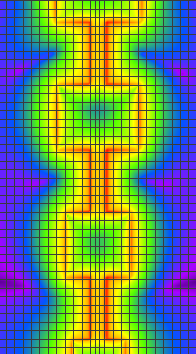Singularity correction is a meshing option that accurately captures highly varying fields at the edges of both good conductor and PEC geometry.
Background

Electromagnetic fields have high spatial variation near metallic edges, particularly when those edges comprise an antenna or transmission line. Discretization errors occur in these regions because numerical techniques assume a linear field transition between neighboring cells. There are two available methods for resolving the fields: cell size reduction and singularity correction.
Reducing the cell size near conductor edges is a straightforward method for increasing accuracy. Smaller cell sizes help resolve field variation, but can negatively impact simulation time due to a smaller timestep and larger memory requirement. PrOGrid's boundary refinement ratio reduces the cell size at geometry edges.
The singularity correction method is more sophisticated and adjusts the electric and magnetic field values adjacent to metallic edges during timestepping. These adjustments are based on analytic models of electromagnetic fields at infinitely sharp edges where singularities occur [1] - [2].
Please log in to view this content.
Remcom customers and those interested in our products may access this content after logging in.